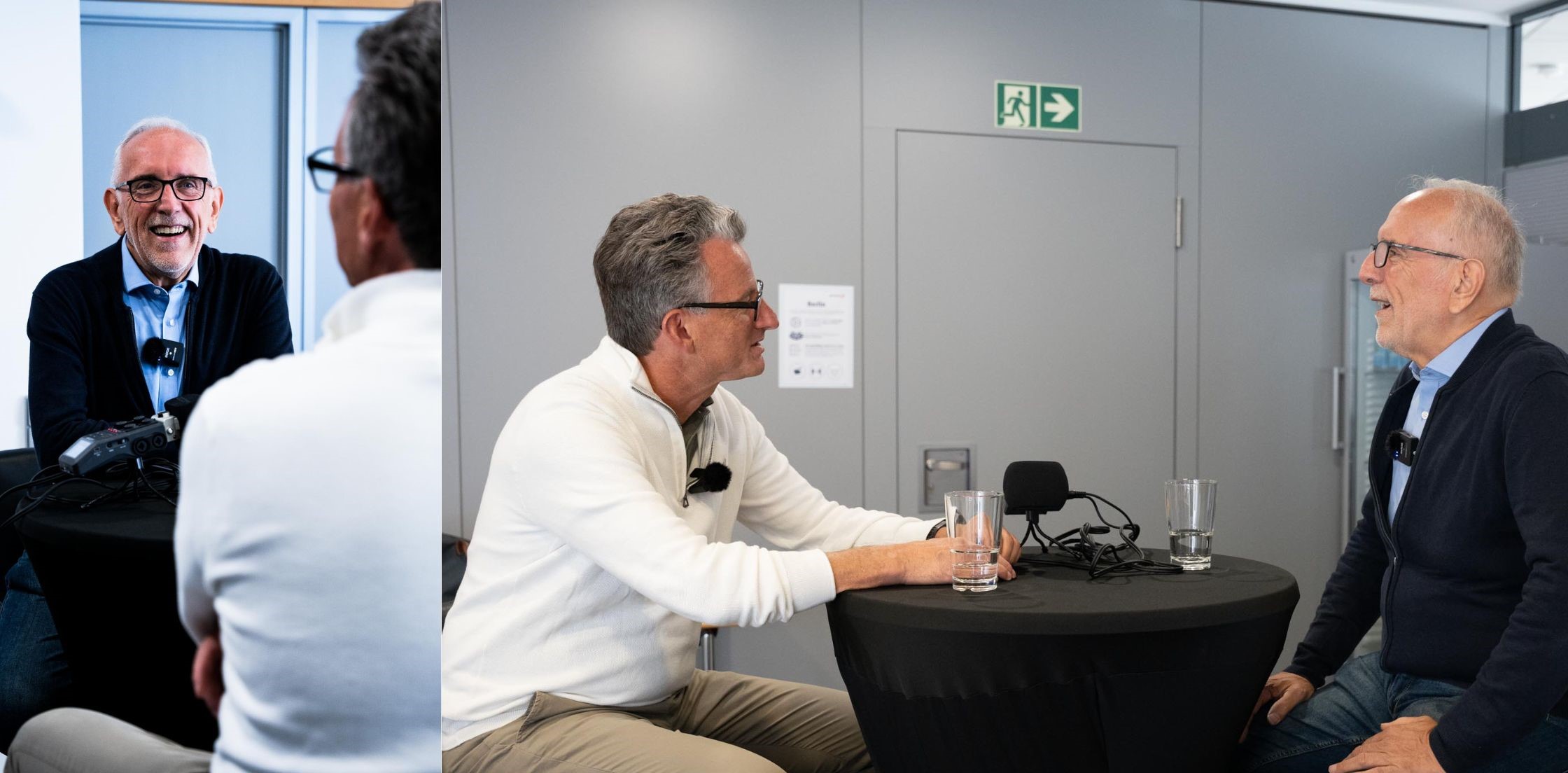Założyciel persolog Friedbert Gay w wywiadzie z Klausem Zimmermannem
Dlaczego persolog istnieje? Jak działa profil czynników osobowości persolog®? Dzisiaj możesz zanurzyć się w historii persolog. Ponieważ nasz założyciel i dyrektor generalny Friedbert Gay był gościem wywiadu w podcaście Klausa Zimmermanna z Zimmermann GmbH & Co. KG i udzielił ekskluzywnego wglądu w swoją pracę i profil persolog. Profil czynników osobowości persolog®. Tutaj można znaleźć fragment wywiadu.
K. Zimmermann: The persolog® Model Czynnika Osobowości to gigantyczne narzędzie, które od wielu lat wykorzystujemy w naszej firmie do rekrutacji pracowników. Opowiedz nam, jak powstała Twoja osobista praca.
Friedbert: Urodziłem się w 1956 roku i dorastałem w Wilferdingen niedaleko Karlsruhe. Powiedziałbym, że jestem późnym deweloperem. Kiedy po raz pierwszy pracowałem jako mistrz elektryk w dziale sprzedaży, po kilku tygodniach zdałem sobie sprawę, że ludzie często nie mają problemów z technologią, ale nie potrafią dogadać się z innymi ludźmi. Od tego wszystko się zaczęło.
Począwszy od 1990 roku wprowadziłem Profil Czynnika Osobowości z USA, najpierw w Niemczech, a następnie w Austrii i Szwajcarii. Jest to moje życiowe osiągnięcie, które rozpoczęło się 33 lata temu. Cieszyłem się życiem, w którym dużo podróżowałem. To mnie bardzo ukształtowało. Moja najstarsza córka, Debora Karsch, prowadzi teraz firmę od strony operacyjnej. Teraz mogę robić rzeczy, które mnie interesują. To przywilej.
persolog GmbH zatrudnia 40 pracowników, co jest dość dużą liczbą w dziedzinie "zaawansowanej edukacji". persolog opracowuje zaawansowane koncepcje edukacyjne, które mogą być wykorzystywane na arenie międzynarodowej. Możemy dostarczać usługi w 34 językach i dlatego podróżujemy po całym świecie. Mamy partnerów i dystrybutorów w 16 krajach. Siedziba główna znajduje się w Remchingen-Wilferdingen.
K. Zimmermann: Powiedziałeś, że możesz dostarczyć 34 języki. Czy tak było od początku, czy jak to się rozwinęło?
Friedbert: Na początku byliśmy "firmą garażową" w domu Jörga Knoblaucha - od tego wszystko się zaczęło. Zbudowanie takiej firmy zajęło kilka lat. Zainwestowaliśmy w nią około 1,4 miliona DM, aż została uruchomiona. Sam nigdy bym tego nie zrobił. Potrzeba było wiele, by cokolwiek osiągnąć. W pewnym momencie zaczęliśmy tłumaczyć treści z języka amerykańskiego i zdaliśmy sobie sprawę, że potrzebujemy również znacznie więcej w kontekście niemieckim. W latach 1997-1999 nastąpił duży wzrost. Napisałem również książkę "Behawioralny plan działania" na przykład z Lotharem Seiwertem, co również zakończyło się sukcesem. Pracowaliśmy nad szeroką gamą produktów.
Otrzymaliśmy różne informacje zwrotne od klientów na temat tego, do czego potrzebowali profili, np. w obszarach sprzedaży, przywództwa lub konfliktów. Często chodziło również o zarządzanie czasem. Profil Czynników Osobowości persolog® nie był tylko kwestionariuszem, ale narzędziem do refleksji. Otrzymywałeś coś, mogłeś wrócić z tym do domu i to naprawdę mówiło ci coś o tobie. To także duża różnica między kwestionariuszami a narzędziami do nauki. Zawsze chodzi o przedstawienie konkretnego problemu w uproszczony sposób i dotarcie do sedna sprawy w danej sytuacji. Jestem osobą, która dostrzega potencjał, a następnie coś z nim robi i idzie do przodu. Tak bym siebie opisał.
K. Zimmermann: W odniesieniu do Profilu Czynników Osobowości persolog®: odpowiadasz na 2×24 pytania i otrzymujesz dokładny wynik. Czy możesz wyjaśnić, skąd w ogóle wziął się ten wynik?
Friedbert: Profil został opracowany na Uniwersytecie Minnesota. Podstawowy rozwój miał miejsce w latach 70-tych. Profesor dr John G. Geier, odpowiedzialny za psychologię na wydziale medycznym, pracował na tym uniwersytecie. Pewnego dnia przyszedł do niego dziekan i powiedział, że przyszli lekarze muszą rozmawiać z ludźmi, a nie z ludźmi, i przekazywać im informacje zwrotne. Ale ludzie stawiali opór: nie chcieli być skanowani przez instrument kliniczny. Profesor dr John G. Geier otrzymał 1,5 miliona dolarów na opracowanie instrumentu, który nie był kliniczny. W tamtym czasie doświadczenie pokazało, że wystarczyło kilka pytań, aby uzyskać znaczące wyniki dotyczące zachowania ludzi. Profesor Geier chciał umożliwić ludziom zastanowienie się i refleksję nad sobą. Opracował więc ten kwestionariusz.
Po dwóch latach opracowywania tego narzędzia do nauki, w 1972 r. przeprowadzono badanie porównawcze ze znanymi badaniami, ponieważ kwestionariusz również musiał zostać przetestowany publicznie. W latach 1988-2000 ponownie rozpoczęto badania. Od 2000 roku zrewidowaliśmy profil i sprawdziliśmy go ilościowo. Od 2004 roku mamy profil prof. Geiera w obecnej formie - z dwoma kwestionariuszami. Kwestionariusz 1 dotyczy pytania "Jak najprawdopodobniej się zachowujesz?", a w kwestionariuszu 2 odpowiadasz na pytanie "Jak najmniej się zachowujesz?".
K. Zimmermann: Dlaczego profil zmienia się, gdy zmienia się ostrość?
Friedbert: Kurt Lewin powiedział: "Zachowanie jest funkcją osoby i środowiska". Osoba jest względnie stabilna, ale środowisko może być inne. Dlatego też zachowanie może być bardzo różne. Psycholog Carl Rogers powiedział: "Ludzie mają kilka obrazów siebie, którymi zarządzają w całkowicie autentyczny sposób". Weźmy przykład: menedżer prawie zawsze ma pracowników, na których może liczyć i pracowników, którzy martwią się o to, co zrobią dzisiaj. Jeśli porównasz rozmowy menedżera z tymi dwiema kategoriami pracowników, zauważysz duże różnice. Podczas gdy jeden ma dużo swobody, drugi jest zarządzany ściślej i częściej kontrolowany. Komunikacja z pracownikiem A bardzo różni się od komunikacji z pracownikiem B.
Albo pomyślmy o kliencie, z którym rozmowa idzie świetnie i o kliencie, który jest dla ciebie bardzo trudny: są to po prostu różne zachowania, które musimy tutaj pokazać i jest całkowicie normalne, że zależy to od środowiska. Znam tylko kilka osób, dla których otoczenie nie odgrywa żadnej roli. Miałem już rozmowy z pracownikami, którzy mówili: "Wiesz, nie muszę przejawiać takich zachowań w domu, bo robi to mój partner". To całkowicie normalne, że w domu zachowujemy się inaczej niż w pracy.
K. Zimmermann: Dlaczego Profil czynników osobowości persolog® działa tak dobrze?
Friedbert: Po prostu przemawia do sytuacji życiowych, a uczestnik może natychmiast coś z tym zrobić. Często można to zaobserwować. W przypadku profilu osobowości mówimy o pierwszym podejściu i pierwszej reakcji ludzi, która często jest inna. Rozpoznanie tego jest bardzo pomocne. Pozwala rozpoznać, w jaki sposób dana osoba się zachowuje i lepiej ją zrozumieć.
Na przykład wiem, że przedstawiam wszystkie informacje komuś, kto jest bardzo ostrożny, w bardzo rzeczowy sposób. Mogę dać komuś, kto jest wysoce dominujący, jasny i bezpośredni wybór: Czy chcesz A, B czy C? Oni chcą decydować za siebie. Ktoś z wysokim poziomem stabilnego zachowania ma łatwiej z rekomendacją. Podnoszę kogoś, kto ma duży wpływ, wyrażając swój entuzjazm dla czegoś. W ten sposób mogę oddać sprawiedliwość moim klientom, pracownikom, partnerowi, a nawet współpracownikom.
Zawsze chodzi o podjęcie decyzji: Co mogę zrobić, aby to, co najlepsze w moim odpowiedniku, mogło się rozwinąć. Dlatego właśnie Profil czynników osobowości persolog® jest tak potężny.
Pełnego wywiadu można wysłuchać tutaj: www.zimmermann-strategie.de



